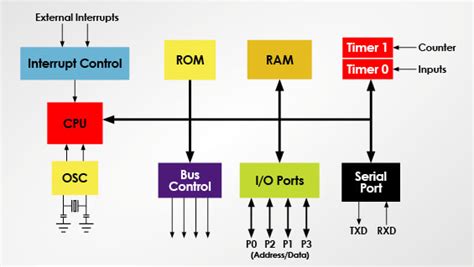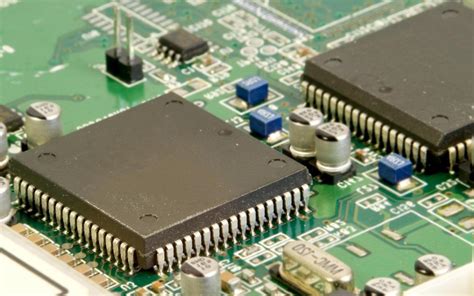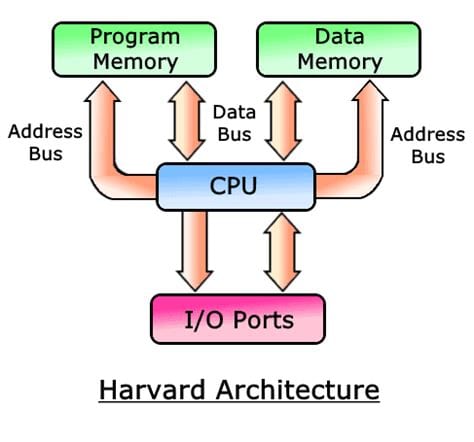Introduction to Microcontrollers
A microcontroller unit (MCU) is a small, integrated Circuit designed to control a specific operation in an embedded system. It is a compact microcomputer that includes a processor core, memory, and programmable input/output peripherals on a single chip. MCUs are widely used in various applications, ranging from household appliances and automobiles to industrial automation and robotics.
Key Features of Microcontrollers
-
Integrated Design: MCUs combine a processor, memory, and peripheral devices in a single chip, making them highly compact and efficient.
-
Low Power Consumption: Microcontrollers are designed to operate on low power, making them suitable for battery-powered and portable devices.
-
Programmability: MCUs can be programmed to perform specific tasks and can be reprogrammed as needed, providing flexibility in design and functionality.
-
Real-time Operation: Microcontrollers can respond to events in real-time, making them ideal for applications that require quick and precise control.
Architecture of Microcontrollers
Processor Core
The processor core is the heart of the microcontroller and is responsible for executing instructions and performing calculations. MCUs typically use a reduced instruction set computing (RISC) architecture, which allows for faster execution of instructions and lower power consumption compared to complex instruction set computing (CISC) architectures.
Some common processor architectures used in MCUs include:
- ARM Cortex-M: A popular choice for low-power and high-performance applications
- 8051: A classic 8-bit architecture still used in many embedded systems
- AVR: A RISC architecture developed by Atmel, now owned by Microchip Technology
- PIC: A RISC architecture developed by Microchip Technology
Memory
Microcontrollers include both volatile and non-volatile memory on-chip. The types of memory used in MCUs are:
-
Read-Only Memory (ROM): Used to store the program code and fixed data. ROM is non-volatile, meaning it retains its contents even when power is removed.
-
Random Access Memory (RAM): Used for temporary data storage during program execution. RAM is volatile, meaning its contents are lost when power is removed.
-
Electrically Erasable Programmable Read-Only Memory (EEPROM): A type of non-volatile memory that can be erased and reprogrammed electrically, used for storing configuration data and other information that may need to be updated.
Input/Output Peripherals
MCUs include a variety of input/output (I/O) peripherals that allow them to interface with external devices and sensors. Some common I/O peripherals found in microcontrollers are:
-
General Purpose Input/Output (GPIO): Pins that can be configured as either inputs or outputs for digital control and sensing.
-
Analog-to-Digital Converter (ADC): Converts analog signals from sensors into digital values that can be processed by the MCU.
-
Digital-to-Analog Converter (DAC): Converts digital values into analog signals for driving external devices.
-
Pulse Width Modulation (PWM): Generates analog-like signals using digital means, often used for motor control and dimming LEDs.
-
Serial Communication Interfaces: Enables communication between the MCU and other devices using protocols such as UART, SPI, and I2C.
-
Timers and Counters: Used for timing events, generating precise delays, and counting external pulses.

Programming Microcontrollers
To program a microcontroller, developers typically use a high-level programming language such as C or C++. The code is then compiled into machine language and loaded onto the MCU’s memory using a programmer or debugger.
Integrated Development Environments (IDEs)
IDEs are software tools that provide a comprehensive environment for writing, compiling, and debugging code for microcontrollers. Some popular IDEs for MCU development include:
-
Arduino IDE: A simple, open-source IDE that supports a wide range of MCUs and has a large user community.
-
Keil µVision: A professional-grade IDE for ARM Cortex-M based MCUs, offered by ARM.
-
MPLAB X: An IDE provided by Microchip Technology for developing applications using PIC and AVR microcontrollers.
-
IAR Embedded Workbench: A powerful IDE that supports various MCU architectures, including ARM, 8051, and AVR.
Debugging and Testing
Debugging and testing are crucial steps in the development process to ensure that the code is functioning as intended and to identify and fix any issues. Some common debugging techniques used in MCU development are:
-
In-Circuit Debugging (ICD): Allows the developer to step through the code, set breakpoints, and monitor variables using a hardware debugger connected to the MCU.
-
Serial Wire Debugging (SWD): A two-wire debugging interface used by ARM Cortex-M based MCUs, providing access to the processor’s debug features.
-
printf() Debugging: A simple technique that involves inserting print statements in the code to output variable values and debug messages to a serial console.
-
Logic Analyzers: Hardware tools that capture and display digital signals, helping to diagnose timing issues and communication problems between the MCU and external devices.

Applications of Microcontrollers
Microcontrollers find applications in a wide range of industries and products. Some common areas where MCUs are used include:
Consumer Electronics
- Home appliances (e.g., washing machines, refrigerators, microwave ovens)
- Remote controls
- Toys and gaming devices
- Wearable electronics
Automotive
- Engine control units (ECUs)
- Anti-lock braking systems (ABS)
- Infotainment systems
- Tire pressure monitoring systems (TPMS)
Industrial Automation
- Programmable logic controllers (PLCs)
- Sensor networks
- Motor control systems
- Robotic arm control
Medical Devices
- Pacemakers
- Blood glucose meters
- Infusion pumps
- Wearable health monitors
Internet of Things (IoT)
- Smart home devices
- Wireless sensor networks
- Wearable devices
- Industrial IoT (IIoT) applications

Popular Microcontroller Families
There are numerous microcontroller families available in the market, each with its own unique features, performance, and target applications. Some popular MCU families include:
Arduino
Arduino is an open-source electronics platform that combines easy-to-use hardware and software. It offers a range of MCU boards based on the AVR architecture, such as the Arduino Uno, Mega, and Nano. Arduino is popular among hobbyists, students, and professionals for its simplicity and extensive community support.
STM32
STM32 is a family of 32-bit ARM Cortex-M based microcontrollers produced by STMicroelectronics. They offer a wide range of performance options, from low-power to high-performance, and are suitable for various applications, including consumer electronics, industrial automation, and medical devices.
PIC
PIC (Peripheral Interface Controller) is a family of 8-bit, 16-bit, and 32-bit microcontrollers developed by Microchip Technology. They are known for their low cost, low power consumption, and wide availability. PIC MCUs are commonly used in automotive, industrial, and consumer applications.
ESP32 and ESP8266
ESP32 and ESP8266 are low-cost, Wi-Fi-enabled microcontrollers produced by Espressif Systems. They are popular for IoT applications due to their integrated Wi-Fi and Bluetooth capabilities, low power consumption, and compatibility with the Arduino IDE.
Choosing the Right Microcontroller
When selecting a microcontroller for a specific application, several factors should be considered:
-
Performance: Consider the processing speed, memory size, and number of I/O peripherals required for the application.
-
Power Consumption: Evaluate the power requirements of the application and choose an MCU that meets those needs while minimizing power consumption.
-
Cost: Determine the budget for the project and select an MCU that provides the necessary features at an acceptable cost.
-
Development Tools and Support: Consider the availability of development tools, libraries, and community support for the chosen MCU family.
-
Scalability: If the application may require future enhancements or modifications, choose an MCU family that offers a range of devices with varying performance and features.
Microcontroller vs. Microprocessor
While microcontrollers and microprocessors may seem similar, they have distinct differences in terms of their design and applications.
| Feature | Microcontroller | Microprocessor |
|---|---|---|
| Integration | Includes processor, memory, and I/O peripherals on a single chip | Typically requires external memory and I/O devices |
| Application | Designed for specific, dedicated tasks in embedded systems | Used for general-purpose computing in personal computers and servers |
| Power Consumption | Low power consumption, suitable for battery-powered devices | Higher power consumption compared to MCUs |
| Cost | Generally lower cost due to high integration | More expensive due to the need for external components |
| Programmability | Programmed for specific tasks, often using high-level languages | Capable of running various applications and operating systems |
| Real-time Performance | Optimized for real-time control and responsiveness | Not typically optimized for real-time performance |
Future Trends in Microcontrollers
As technology advances, microcontrollers continue to evolve to meet the demands of new applications and market trends. Some notable trends in MCU development include:
-
Increased Integration: MCUs are incorporating more features and peripherals on-chip, such as wireless connectivity, advanced security, and energy harvesting capabilities.
-
Enhanced Security: With the growing importance of cybersecurity, MCUs are offering enhanced security features like hardware-based encryption, secure boot, and tamper detection.
-
Artificial Intelligence (AI) and Machine Learning (ML): Some MCUs are starting to include hardware accelerators for AI and ML tasks, enabling edge computing and smart, autonomous devices.
-
Low-Power Operation: As battery-powered and energy-harvesting devices become more common, MCUs are being designed for even lower power consumption and more efficient power management.
-
Open-Source Hardware: The popularity of open-source hardware platforms like Arduino and Raspberry Pi is driving the development of more accessible and customizable MCU solutions.
Frequently Asked Questions (FAQ)
-
What is the difference between an MCU and a CPU?
An MCU is a complete microcomputer on a single chip, including a processor, memory, and I/O peripherals. A CPU, on the other hand, is just the processor core and requires external memory and I/O devices to function as a computer. -
Can I program an MCU using Python?
While C and C++ are the most common languages for MCU programming, some microcontroller platforms, such as the Raspberry Pi Pico and the MicroPython-enabled boards, support programming in Python. -
What is the best MCU for beginners?
Arduino boards, such as the Arduino Uno, are often recommended for beginners due to their simplicity, extensive documentation, and large user community. -
How do I choose the right MCU for my project?
When selecting an MCU, consider factors such as performance requirements, power consumption, cost, and available development tools and support. Evaluate your project’s specific needs and choose an MCU that meets those requirements. -
Can I use an MCU for machine learning applications?
Some advanced MCUs are starting to include hardware accelerators for machine learning tasks, enabling edge computing and AI-powered applications. However, the capabilities of these MCUs are still limited compared to more powerful processors used in computers and servers.
Conclusion
Microcontrollers are essential components in the world of embedded systems, enabling the creation of smart, efficient, and cost-effective devices. With their compact size, low power consumption, and programmability, MCUs find applications in a wide range of industries, from consumer electronics and automotive to industrial automation and medical devices.
As technology continues to advance, microcontrollers are evolving to meet the demands of new applications and market trends, offering enhanced features, increased integration, and improved performance. By understanding the fundamentals of MCUs and their applications, designers and developers can create innovative solutions that shape the future of embedded systems.

No responses yet